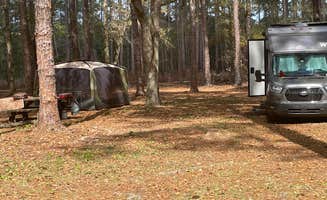Dispersed camping near Eastpoint, Florida offers primitive wilderness experiences within the Apalachicola National Forest's 632,890 acres. Summer temperatures often exceed 90°F with high humidity, while winter nights can drop below 40°F. Forest roads throughout the camping areas become muddy after rain, with sand-based trails posing occasional challenges for vehicles without adequate clearance.
What to do
Water exploration: Bring your own vessel to enjoy paddling opportunities in the forest's extensive waterways. At Porter Lake Dispersed Camp, a visitor notes, "The river is beautiful to boat or kayak and fish." Water access points at multiple sites allow for launching small watercraft.
Wildlife observation: Dawn and dusk provide optimal viewing times for native Florida species. The forest hosts over 300 bird species and numerous mammals. Look for white-tailed deer, wild turkeys, and various amphibians near water sources.
Foraging: Seasonal opportunities exist for collecting edible plants like blackberries (May-June) and mushrooms (during rainy periods). Research regulations and identification before harvesting any forest products.
Fishing: License required for freshwater fishing in forest lakes and streams. Local waters contain bass, bream, and catfish species. Regulations prohibit commercial fishing and limit daily catches.
What campers like
Remote solitude: Weekday visits tend to provide the most isolated camping experiences. At Buckhorn Hunt Camp, campers appreciate that it's "not all that busy outside of hunting season" with "spots [that] are reasonably private," according to visitor Thomas V.
Accessibility: Most dispersed sites remain reachable by standard vehicles during dry conditions. Access improves during winter and spring when ground conditions firm up and vegetation thins out.
Budget-friendly: No fees apply at most dispersed camping areas within the Apalachicola National Forest. Porter Lake offers amenities while maintaining free access, making it popular with budget-conscious travelers seeking "a quick getaway from city life," as camper Christin P. describes.
Night skies: Minimal light pollution creates excellent stargazing opportunities. Clear winter nights provide optimal viewing conditions without summer's typical humidity and haze.
What you should know
Supply planning: No nearby services means carrying all necessary provisions. The closest convenience stores sit 30+ minutes from most camping areas. At Porter Lake Dispersed Camp, one camper points out it's "at least 30 miles either way on F13 (dirt road to campground) and other routes to any type of civilization."
Water sources: Limited availability throughout the forest requires bringing adequate drinking water. Porter Lake has a spigot but lacks potable water certification. Camper Annette L. observes, "They say non potable but there are no signs."
Road conditions: Forest Service roads vary seasonally and after weather events. Many become impassable for low-clearance vehicles during wet periods. Logging operations may temporarily restrict access or increase traffic on weekdays.
Weather preparation: Sudden storms can develop year-round. Summer afternoons frequently produce thunderstorms with lightning risks. The forest floor may flood quickly in low-lying camping areas.
Tips for camping with families
Site selection: Choose established clearings away from dead trees or hanging branches. Areas with natural barriers like shrubs provide additional safety and privacy between campsites.
Insect protection: Multiple strategies help manage mosquitoes and ticks during warmer months. Long clothing, repellents, and mosquito netting improve comfort, especially during dawn and dusk hours when insect activity peaks.
Wildlife safety: Proper food storage prevents unwanted animal encounters. Use sealed containers and never leave food unattended. At Twin Poles Hunt Camp, proper food management helps minimize raccoon and other small mammal issues.
Activity timing: Morning hours provide the most comfortable temperatures for family activities during summer months. Plan water activities for afternoon cooling and wildlife viewing for early morning or evening.
Tips from RVers
Size limitations: Small to medium rigs navigate forest roads more successfully. Class B and smaller Class C motorhomes handle the terrain better than larger models. Most dispersed sites accommodate vehicles under 25 feet in length.
Leveling challenges: Bring adequate blocks as most forest sites feature uneven terrain. Natural surfaces may shift during rain, requiring readjustment of stabilizing equipment.
Generator usage: Restricted hours apply in most camping areas. At Cliff Lake Hunt Camp in Apalachicola Forest, campers typically observe quiet hours from 10 PM to 7 AM.
Waste management: Pack-out systems required as no dump stations exist at dispersed sites. The nearest RV dump facilities are located in developed campgrounds outside the forest boundaries, typically 30+ minutes away.


